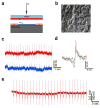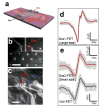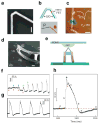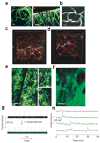Nanoelectronics-biology frontier: From nanoscopic probes for action potential recording in live cells to three-dimensional cyborg tissues
- PMID: 24073014
- PMCID: PMC3781175
- DOI: 10.1016/j.nantod.2013.05.001
Nanoelectronics-biology frontier: From nanoscopic probes for action potential recording in live cells to three-dimensional cyborg tissues
Abstract
Semiconductor nanowires configured as the active channels of field-effect transistors (FETs) have been used as detectors for high-resolution electrical recording from single live cells, cell networks, tissues and organs. Extracellular measurements with substrate supported silicon nanowire (SiNW) FETs, which have projected active areas orders of magnitude smaller than conventional microfabricated multielectrode arrays (MEAs) and planar FETs, recorded action potential and field potential signals with high signal-to-noise ratio and temporal resolution from cultured neurons, cultured cardiomyocytes, acute brain slices and whole animal hearts. Measurements made with modulation-doped nanoscale active channel SiNW FETs demonstrate that signals recorded from cardiomyocytes are highly localized and have improved time resolution compared to larger planar detectors. In addition, several novel three-dimensional (3D) transistor probes, which were realized using advanced nanowire synthesis methods, have been implemented for intracellular recording. These novel probes include (i) flexible 3D kinked nanowire FETs, (ii) branched intracellular nanotube SiNW FETs, and (iii) active silicon nanotube FETs. Following phospholipid modification of the probes to mimic the cell membrane, the kinked nanowire, branched intracellular nanotube and active silicon nanotube FET probes recorded full-amplitude intracellular action potentials from spontaneously firing cardiomyocytes. Moreover, these probes demonstrated the capability of reversible, stable, and long-term intracellular recording, thus indicating the minimal invasiveness of the new nanoscale structures and suggesting biomimetic internalization via the phospholipid modification. Simultaneous, multi-site intracellular recording from both single cells and cell networks were also readily achieved by interfacing independently addressable nanoprobe devices with cells. Finally, electronic and biological systems have been seamlessly merged in 3D for the first time using macroporous nanoelectronic scaffolds that are analogous to synthetic tissue scaffold and the extracellular matrix in tissue. Free-standing 3D nanoelectronic scaffolds were cultured with neurons, cardiomyocytes and smooth muscle cells to yield electronically-innervated synthetic or 'cyborg' tissues. Measurements demonstrate that innervated tissues exhibit similar cell viability as with conventional tissue scaffolds, and importantly, demonstrate that the real-time response to drugs and pH changes can be mapped in 3D through the tissues. These results open up a new field of research, wherein nanoelectronics are merged with biological systems in 3D thereby providing broad opportunities, ranging from a nanoelectronic/tissue platform for real-time pharmacological screening in 3D to implantable 'cyborg' tissues enabling closed-loop monitoring and treatment of diseases. Furthermore, the capability of high density scale-up of the above extra- and intracellular nanoscopic probes for action potential recording provide important tools for large-scale high spatio-temporal resolution electrical neural activity mapping in both 2D and 3D, which promises to have a profound impact on many research areas, including the mapping of activity within the brain.
Keywords: bioelectronics; brain activity mapping; cellular and subcellular resolution; field-effect transistor; flexible electronics; graphene; macroporous 3D electronics; nanodevice; nanowire; synthetic tissue.
Figures
















Similar articles
-
Mesh Nanoelectronics: Seamless Integration of Electronics with Tissues.Acc Chem Res. 2018 Feb 20;51(2):309-318. doi: 10.1021/acs.accounts.7b00547. Epub 2018 Jan 30. Acc Chem Res. 2018. PMID: 29381054 Free PMC article.
-
Intracellular recordings of action potentials by an extracellular nanoscale field-effect transistor.Nat Nanotechnol. 2011 Dec 18;7(3):174-9. doi: 10.1038/nnano.2011.223. Nat Nanotechnol. 2011. PMID: 22179566 Free PMC article.
-
Graphene and nanowire transistors for cellular interfaces and electrical recording.Nano Lett. 2010 Mar 10;10(3):1098-102. doi: 10.1021/nl1002608. Nano Lett. 2010. PMID: 20136098 Free PMC article.
-
Nanoelectronics meets biology: from new nanoscale devices for live-cell recording to 3D innervated tissues.Chem Asian J. 2013 Oct;8(10):2304-14. doi: 10.1002/asia.201300630. Epub 2013 Aug 15. Chem Asian J. 2013. PMID: 23946279 Free PMC article. Review.
-
Application of Silicon Nanowire Field Effect Transistor (SiNW-FET) Biosensor with High Sensitivity.Sensors (Basel). 2023 Jul 30;23(15):6808. doi: 10.3390/s23156808. Sensors (Basel). 2023. PMID: 37571591 Free PMC article. Review.
Cited by
-
Organic bioelectronics probing conformational changes in surface confined proteins.Sci Rep. 2016 Jun 17;6:28085. doi: 10.1038/srep28085. Sci Rep. 2016. PMID: 27312768 Free PMC article.
-
Talking to cells: semiconductor nanomaterials at the cellular interface.Adv Biosyst. 2018 Apr;2(4):1700242. doi: 10.1002/adbi.201700242. Epub 2018 Feb 26. Adv Biosyst. 2018. PMID: 30906852 Free PMC article.
-
Engineered hybrid cardiac patches with multifunctional electronics for online monitoring and regulation of tissue function.Nat Mater. 2016 Jun;15(6):679-85. doi: 10.1038/nmat4590. Epub 2016 Mar 14. Nat Mater. 2016. PMID: 26974408 Free PMC article.
-
Cell maturation: Hallmarks, triggers, and manipulation.Cell. 2022 Jan 20;185(2):235-249. doi: 10.1016/j.cell.2021.12.012. Epub 2022 Jan 6. Cell. 2022. PMID: 34995481 Free PMC article. Review.
-
Taking Electrons out of Bioelectronics: From Bioprotonic Transistors to Ion Channels.Adv Sci (Weinh). 2017 Mar 14;4(7):1600527. doi: 10.1002/advs.201600527. eCollection 2017 Jul. Adv Sci (Weinh). 2017. PMID: 28725527 Free PMC article. Review.
References
-
- Hille B. Ion Channels of Excitable Membranes. 3. Sinauer Associates Inc; Sunderland: 2001.
-
- Dunlop J, Bowlby M, Peri R, Vasilyev D, Arias R. Nature Rev Drug Discov. 2008;7:358–368. - PubMed
-
- Meyer T, Boven KH, Gunther E, Fejtl M. Drug Safety. 2004;27:763–772. - PubMed
-
- Dhein S, Mohr FW, Delmar M. Practical Methods in Cardiovascular Research. Springer-Verlag; Berlin: 2005. pp. 215–453.
Grants and funding
LinkOut - more resources
Full Text Sources
Other Literature Sources
